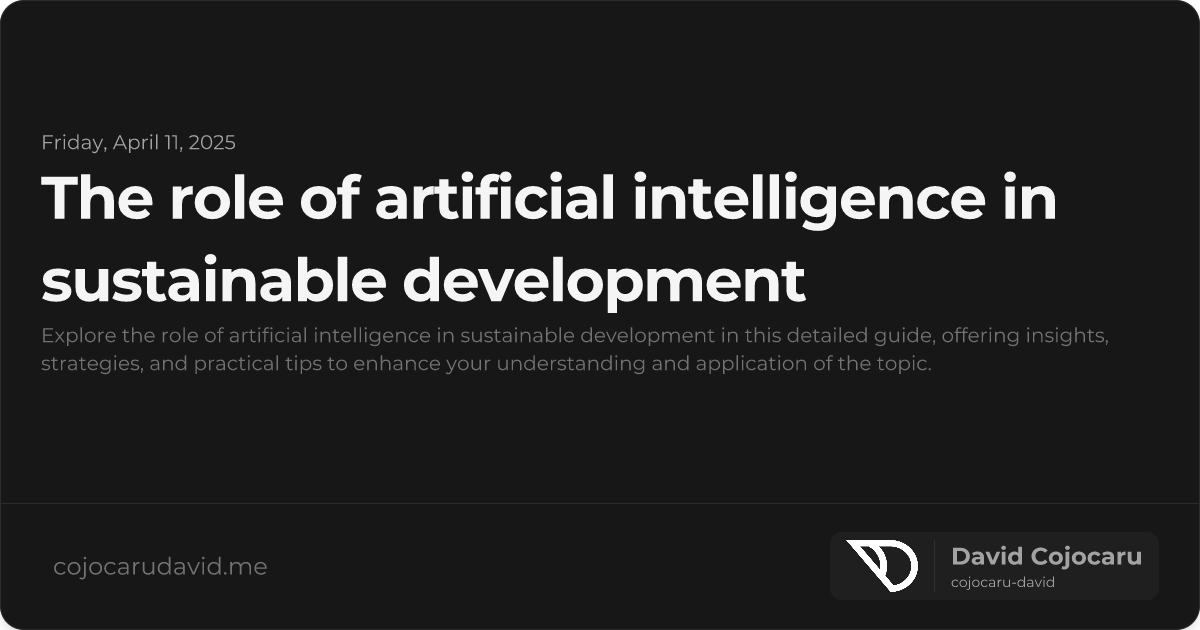Powering a Sustainable Future: The Role of Artificial Intelligence
Artificial Intelligence (AI) is rapidly transforming industries across the globe, and its potential to drive sustainable development is immense. From optimizing resource management to mitigating climate change, AI offers innovative solutions to some of the world’s most pressing environmental and social challenges. This post explores how AI is contributing to a more sustainable future, highlighting real-world applications, addressing key challenges, and looking ahead at future possibilities.
AI: A Powerful Tool for Achieving the Sustainable Development Goals (SDGs)
The United Nations’ 17 Sustainable Development Goals (SDGs) provide a comprehensive roadmap for a better world. AI can significantly accelerate progress towards these goals by offering data-driven insights and automating complex processes. Here are a few key examples:
- Combating Climate Change (SDG 13): AI algorithms can analyze vast datasets to predict extreme weather events, optimize energy consumption in smart grids, and accelerate the development of renewable energy sources.
- Ensuring Clean Water and Sanitation (SDG 6): Machine learning models can detect water contamination with greater speed and accuracy than traditional methods, enabling faster responses and improved water resource management. AI can also optimize water distribution systems, reducing leaks and waste.
- Promoting Responsible Consumption and Production (SDG 12): AI-powered supply chain optimization can minimize waste by accurately predicting demand, improving logistics, and facilitating the reuse and recycling of materials.
- Protecting Life on Land (SDG 15): Computer vision and machine learning are used to track endangered species, monitor deforestation in real time, and combat illegal wildlife trade.
These are just a few examples of how AI is being used to address critical sustainability challenges. The potential for further innovation is enormous.
Real-World Applications: AI in Action
Precision Agriculture: Cultivating a More Sustainable Food System
AI is revolutionizing agriculture by enabling precision farming techniques. Drones and sensors collect data on soil health, moisture levels, and plant growth, allowing farmers to optimize irrigation, fertilization, and pesticide application. This results in higher crop yields with reduced water consumption and environmental impact.
Protecting Wildlife with AI: A Guardian for Endangered Species
Conservationists are increasingly using AI to protect endangered species. AI algorithms analyze camera trap images to identify animals, track their movements, and detect poaching activities. This information helps conservationists deploy resources more effectively and protect vulnerable populations.
Smarter Cities, Cleaner Air: AI for Pollution Control
Machine learning models can analyze air quality data from various sources to predict pollution levels and identify pollution sources. Cities can use these insights to implement targeted emission-reduction strategies, improve public health, and create cleaner, more livable environments.
Navigating the Challenges: Ethical Considerations and Responsible Implementation
While AI offers tremendous potential for sustainable development, it’s crucial to address potential challenges and ensure responsible implementation:
- Energy Consumption: Training complex AI models can require significant computational power, raising concerns about carbon emissions. We need to prioritize the development of energy-efficient AI algorithms and utilize renewable energy sources for AI infrastructure.
- Data Bias: AI models are only as good as the data they are trained on. Inaccurate or biased datasets can lead to flawed predictions and perpetuate inequalities. It’s essential to ensure that data used for AI applications is representative, accurate, and unbiased.
- Accessibility and Equity: Developing nations may lack the infrastructure and resources to deploy AI solutions effectively, potentially widening the gap between developed and developing countries. International collaboration and technology transfer are crucial to ensure equitable access to AI for sustainable development.
The Future is Intelligent: Emerging Trends and Opportunities
The role of AI in sustainability will only continue to grow in the coming years. Here are a few emerging trends to watch:
- Autonomous Renewable Energy Systems: AI will optimize the performance of solar and wind farms, enabling more efficient and reliable renewable energy generation.
- Circular Economy Revolution: AI can identify opportunities for recycling and upcycling waste materials, creating more circular and sustainable economies.
- Smart and Sustainable Cities: AI will integrate urban planning with sustainability goals, optimizing traffic flow, reducing energy consumption, and improving resource management in cities.
Collaboration is key: Policymakers, technologists, environmentalists, and communities must work together to harness the full potential of AI for a sustainable future.
Conclusion: Embracing AI for a Greener Tomorrow
AI is a powerful catalyst for sustainable development, offering data-driven solutions to some of the world’s most pressing challenges. From conserving ecosystems to optimizing resource use, AI empowers us to build a more sustainable and resilient world. By addressing the challenges and implementing AI responsibly, we can unlock its transformative potential and accelerate progress towards a brighter, greener future for all.
“AI is not just a tool for innovation; it’s a powerful engine for driving a sustainable and equitable future.”
Let’s embrace the power of AI to create a world where economic prosperity and environmental stewardship go hand in hand.

